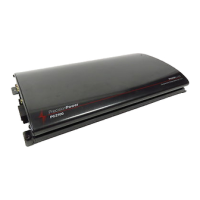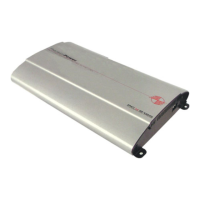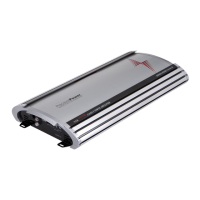Do you have a question about the Precision Power A600.2 and is the answer not in the manual?
Read instructions, follow all guidance, heed wiring and fusing requirements.
Keep sales receipt for warranty, do not attempt self-servicing.
Avoid water/moisture, heed caution about hearing loss and traffic hazards.
Definitions for AM II, Bridging, Gain, L.E.D., Load Impedance, Mixed Mono, PWM, Remote Turn-On, ACM.
PWM Power Supply, Regulated Power Supply, Discrete Power Amp Circuitry.
Internally Bridgeable, Mixed Stereo/Mono, Output Short Circuit Protection, Differential Input Stage.
Low Impedance Protection, Adjustable Input Sensitivity, Gold RCA Connectors, Wire Connection System.
Liquid Cooling, ACM Compatibility, Three Year Limited Warranty, USA Manufacturing.
Continuous power output per channel for different Art Series models at various impedances.
Lists common parameters like power bandwidth, THD, input sensitivity, impedance, and supply voltage.
Details the PWM power supply's function, efficiency, and thermal management benefits.
Explains the innovative heatsink design for improved radiant heat transfer efficiency.
Outlines the protection circuits that operate at low voltage or high temperature.
Mentions the second generation of PPI's Adaptive MOSFET protection circuitry.
Describes how the ACM enables central muting and the LED indicator behavior.
Details ACM-420's capability to control multiple amplifiers and enable synchronized restart.
Details how AM II prevents shut-off due to low impedance loads, with an indicator.
Explains AM III protection for shorted channels and audible distortion.
Explains how isolation resistors prevent alternator noise interference.
Highlights the use of discrete output transistors for superior audio performance.
Discusses blade fuse advantages for over-load protection and reliability.
Recommends fusing the power cable at the battery for safety.
Strongly recommends professional installation by trained personnel.
Lists necessary tools and parts for installation that are not supplied.
Guidance on secure mounting for proper airflow and heat dissipation.
Specifies the need for at least two inches of clearance around the amplifier.
Emphasizes battery disconnection and recommended wire gauges.
Instructions for routing cables and using grommets to prevent damage.
Details making a solid ground connection and fuse placement.
Instructions for connecting power and ground wires to the amplifier connector.
Connecting to a switched 12V source and routing the wire through the vehicle.
Guidance for routing speaker wires and recommended gauge.
Instructions for connecting speaker leads and checking polarity.
Explains bridging for mono output and various configuration flexibilities.
Specifies impedance requirements and how to achieve mixed mono.
Describes RCA inputs and the function of the "2/4 way" switch.
Identifies gain control and provides adjustment steps for optimal volume.
Procedure to set equalizer input gains for optimal signal-to-noise ratio and balance.
Procedure to set crossover gain controls for proper signal level without distortion.
Procedure to set amplifier input gains for optimal volume and minimal noise.
Checks power LED, fuses, and turn-on lead for no sound problems.
Addresses checks for speaker leads, pre-amp leads, and mono bridge switches.
Guides on checking cooling, speaker shorts, and power/ground security.
Diagram showing a typical two-channel stereo system setup.
Diagram illustrating a mixed mono system with derived mono channel.
Diagram showing a bi-amp system using the EPX-223 crossover.
Diagram showing bi-amp system using EPX-223 with band-pass for mid-bass drivers.
Diagram of a bi-amp system using FRX-456 with front/rear fade capability.
Diagram of an active system using FRX-456 with individual driver outputs.
| RMS Power at 4 Ohms | 150W x 2 |
|---|---|
| RMS Power at 2 Ohms | 300W x 2 |
| Bridged RMS Power at 4 Ohms | 600W x 1 |
| THD at Rated Power | <0.05% |
| Crossover Slope | 12dB/Octave |
| Crossover | LP/HP |



